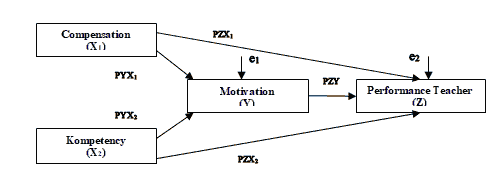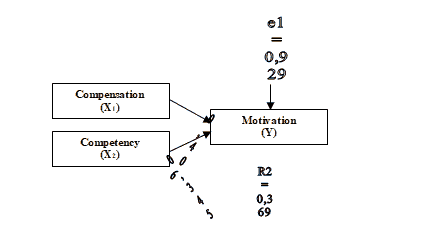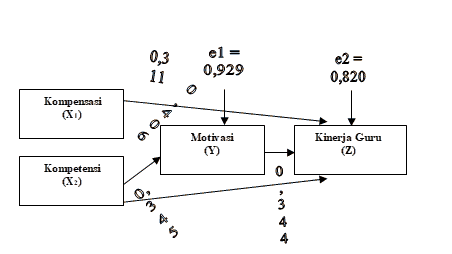Research Article: 2022 Vol: 21 Issue: 2S
Motivation and performance analysis of teachers in SMA swasta tamansiswa tapian dolok
Darwin Lie, Sekolah Tinggi Ilmu Ekonomi Sultan Agung
Lora E. Nainggolan, Sekolah Tinggi Ilmu Ekonomi Sultan Agung
Nana T. Nainggolan, Sekolah Tinggi Ilmu Ekonomi Sultan Agung
Keywords
Compensation, Motivation, Teacher Performance
Citation Information
Lie, D., Nainggolan, L.E., & Nainggolan, N.T. (2022). Motivation and performance analysis of teachers in SMA swasta tamansiswa tapian dolok. Academy of Strategic Management Journal, 21(S2), 1-7.
Abstract
This study aims to analyze the impact of compensation and competence on teacher motivation and performance. The research object is the teacher of the Tamansiswa Tapian Dolok Private High School, which amounts to 30 people. Data was collected through the distribution of questionnaires to respondents—data analysis using path analysis. The research analysis results showed that the compensation, competence, motivation, and teacher's performance were reasonable. Thus, the results show an effect of balance and competence on teacher motivation and performance.
Introduction
In the world of education, schools rely on discipline, responsibility, creativity, and expertise (Nainggolan, Siahaan & Nainggolan, 2020). Education is part of activities that involve educators and education personnel. Professional educators involve educational instruments to create a learning process that develops the students' potential (Iskandar & Juhana, 2014). Although there are government efforts to improve teacher qualification standards, there are still teachers whose performance is not yet optimal. For example, at the Tamansiswa Tapian Dolok Private High School, two factors are still not optimal, such as mastering students and developing curriculum.
To support teacher performance, motivation is an essential factor so that teachers can contribute in school. In line with research (Riyadi & Mulyapradana, 2017) which states that work motivation has a positive and significant influence on teacher performance, it is acceptable and proven to have a positive impact.
Motivation is a driving force for creating individual performance and organizational performance (Sutrisno, 2011; Kreitner & Kinicki, 2014) explains the hierarchical level of human needs, including physiological, security, social, esteem, self-actualization. When each condition is essentially satisfied, the following need becomes dominant, which means that even if no demand is met, a nearly happy requirement is no longer motivating. If you want to motivate individuals, first understand their needs and the needs above them.
The phenomenon in Tamansiswa Tapian Dolok Private High School regarding teacher motivation is that there are unmet needs that affect teachers' motivation to work, such as the need for security, where schools still do not provide old-age guarantees for teachers who have retired from work. The need for awards is also not evenly distributed, such as obtaining teacher certification. Regarding the level of self-actualization needs, there are still teachers who do not develop themselves, such as increasing education to the Masters's story; this is due to the unclear career path at the school.
Teachers must have performance standards to direct students to adapt to social changes in society and the development of science and technology (Budiman, 2016). Compensation teachers are more aware of the things and responsibilities as professionals. (Kasmir, 2016). For example, the compensation received by the Tamansiswa Tapian Dolok Private High School teacher is a direct and indirect settlement in Simalungun Regency. Likewise, non-financial compensation has not supported teachers in their work, namely the lack of laptops and infocus, which teachers need to simplify the learning process in class.
As in academic competence, several teachers at the Tamansiswa Tapian Dolok Private High School whose competence is not yet optimal, teachers' enthusiasm and willingness to achieve their best performance and are less able to master the delivery of learning materials because teaching techniques are still not optimally implemented by the applicable curriculum development. Based on the description above, there is a gap between the theory which explains that the provision of appropriate compensation and teacher competence will increase motivation at work so that it impacts teacher performance. The fact that there are still several factors from each of the variables studied has not been optimally implemented.
Theoretical Basis
Compensation
Compensation is a person's thing, and the organization must provide it. Compensation also includes forms of pay given to employees arising from their employment relationship (Dessler, 2015). Compensation is everything received for its contribution to the organization (Sedarmayanti, 2017). Compensation strongly encourages high performance (Rumukaun et al., 2019). All organizations have goals that can improve competence and ability to work. (Sedarmayanti, 2017). Fair compensation will provide many benefits.
(Kasmir, 2016) the purpose of compensation is: To provide employee rights, in this case, the organization's obligation to provide compensation to all its members. To give a sense of fairness, the prize given must be open, and the determination of the amount of payment is based on the performance of each member of the organization. Obtaining qualified human resources with reasonable compensation will attract qualified applicants to apply to the organization.
The purpose of compensation is to attract employees and retain qualified employees. The compensation system will work effectively if it can motivate its employees and align with applicable legal regulations. From the description above, it can be explained that the factors that influence the provision of compensation include experience, skills, education, workload, or working conditions to create justice for each employee.
Teacher Competency
To achieve teacher performance, it is necessary to have competence so that the learning process in schools can also run effectively and efficiently. Broke and Stone (Mulyasa, 2009) explains that teacher competence is a qualitative description of the nature of meaningful teacher behavior. Pedagogic competence refers to the ability to carry out something that is obtained through education.
Competency standards are carried out to obtain excellent and professional teachers who have the competence to carry out the functions and goals of the school and educational goals in general according to the community's needs and the demands of the times. Therefore, according to (Law of the Republic of Indonesia, 2005), teacher competence consists of academic competence, professional competence, and social competence.
Motivation
Motivation is one of the factors that encourage someone to do a particular activity. Therefore motivation is often interpreted as a factor driving organizational behavior (Sutrisno, 2009). (Sedarmayanti, 2017) motivation is a force that encourages a person to take action or not, which exists internally and externally as well as positive and negative to direct it, depending on the toughness of the leader. The key to understanding the motivational process depends on understanding and the relationship between several factors (Luthans, 2006): 1. Needs, needs are created when there is no physiological or psychological balance. 2. An urge, drive, or motive is formed to reduce the need. Physiological and psychological drives are action-oriented and generate the driving force in achieving incentives. It is a process of motivation 3. Incentives, by obtaining incentives, will tend to restore physiological or psychological balance and reduce the drive. If the motivation given by the leader to subordinates has been implemented, then the leader has provided good motivation. From this description, it can be concluded that internal and external factors can affect the motivational process in an organization. From the explanation of the theory above, the dimensions used to measure a person's motivation at work are the theory explained by Abraham Maslow, namely physiological needs, security, social, appreciation, self-actualization.
Performance
Mathis in (Nainggolan, Siahaan & Nainggolan, 2020) performance is achieved by a person if they carry out tasks that are completed based on experience, sincerity, and skill, and the time given. A person's performance is faced with task demands. A person's performance appraisal is an integral part of the appraisal process, including setting specific, measurable, rate-of-change, time-limited performance goals (Lie, 2012). Performance refers to the notion that behavior is a set of behaviors relevant to the purposes of the organization or organizational unit where people work.
Research Methodology
The object of this research is the Tamansiswa Tapian Dolok Private High School teachers totaling 30 people. Data collection techniques using interviews and questionnaires. Sources of data used are primary and secondary. Data analysis used descriptive qualitative, and quantitative. While the research design can be described as follows:
1. Information:
2. X1: Compensation
3. X2: Teacher Competence
4. Y: Motivation
5. Z: Teacher Performance
6. e : error
7. The structural equation for the path diagram above is:
Y = PYX1+PYX2+?1
Z = PZX1+PZX2+PZY+?2
Discussion
Measurement of teacher compensation at the Tamansiswa Tapian Dolok Private High School through the provision of financial compensation and non-financial compensation. Overall, from the nine indicators of teacher compensation, the average value obtained is 4.24 perfect criteria. For the indicator, the highest value is the relationship with co-workers, and the lowest is the basic salary given, which is still below the UMR in Simalungun Regency.
The indicator that has the highest score is the indicator of the teacher's ability to provide an evaluation of the given performance, the teacher's ability to use information and communication technology to support the learning process, and the indicator on the level of the principle of togetherness that fellow teachers own. But there are still indicators that have low scores for teacher competence, namely the hand of the teacher's ability to have concepts and methods of scientific, technological, and artistic disciplines.
Every school needs educators as part of the school to achieve the goals and success of a school. Motivation is a driving force that can influence and direct educators to carry out certain activities to achieve school goals. Of the respondents' answers regarding motivation at the Tamansiswa Tapian Dolok Private High School, the average score was 3.43, with suitable criteria. The highest average value is found in the timeliness indicator of the salary earned. The lowest hand is located in the arrow of self-development ability.
Based on the results of the questionnaire distributed to teachers. Overall, the total respondents' answers regarding teacher performance obtained an average score of 3.94 with good answer criteria. The highest score on the indicator of teacher participation in providing learning for students and hands of adjusting the implementation of learning with the syllabus. Where the lowest indicator is the mastery of the characteristics of students who are still quite good.
The results of the calculation of the analysis in the form of coefficients of Compensation (X1) and Teacher Competence (X2) on Motivation (Y), the results of the study are as follows:
| Table 1 Calculation Of The Analysis In The Form Of Coefficients Of Compensation (X1) And Teacher Competence (X2) On Motivation (Y) |
||||
|---|---|---|---|---|
| Model | Unstandardized Coefficients | Standardized Coefficients | ||
| B | Std. Error | Beta | ||
| 1 | (Constant) | 20,326 | 7,925 | |
| Kompensasi | ,445 | ,176 | ,406 | |
| Kompensasi | ,317 | ,148 | ,345 | |
From the results of the SPSS version 21 data processing program in test 1, the equation in table 1 is obtained as follows:
Y= 0,406 X1+0,345 X2+0,929?Based on the results of the path analysis in table 4, it is explained that there is a positive influence of compensation and competence on teacher motivation. If compensation and competence increase by 1 unit, it will increase motivation by 0.406X1 and 0.345 X2. Then the path analysis diagram can be described as follows:
The results of the analysis calculation in the form of compensation coefficiencies (X1) and competence (X2) to teacher performance (Z) through Motivation (Y) are as follows:
| Table 2 Analysis Calculation In The Form Of Compensation Coefficiencies (X1) And Competence (X2) To Teacher Performance (Z) Through Motivation (Y) |
||||
|---|---|---|---|---|
| Model | Unstandardized Coefficients | Standardized Coefficients | ||
| B | Std. Error | Beta | ||
| 1 | (Constant) | 24,020 | 24,346 | |
| Kompensasi | 1,119 | ,540 | ,311 | |
| Kompetensi | ,912 | ,440 | ,302 | |
| Motivasi | 1,129 | ,530 | ,344 | |
Based on the results of the analysis in Table 2, the path coefficient values of X1 and X2 to Z through Y are: ZX1= 0.311, ZX2= 0.302 and ZY= 0.344 and the residual coefficient is as follows:
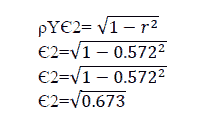
?2=0.820
So that the modeling value for the second equation is known as follows:
Z= 0.311 X1+ 0,302 X2+0.344Y+0.820 ?2
From the path analysis equation above, it is found that compensation and competence positively affect performance through motivation. If balance, competence, and inspiration, the teacher's routine will increase by 0.311 (X1), 0.302 (X2), 0.344 (Y).
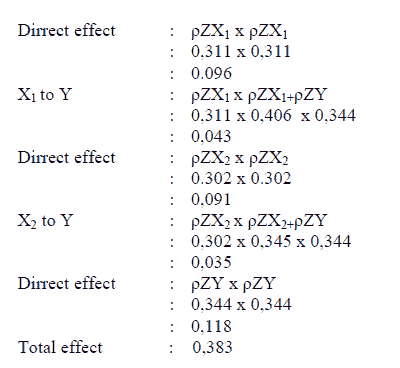
The Effect of Compensation and Teacher Competence on Motivation
Based on the research results that have been done, the results of the calculation of the regression analysis obtained the results of the effect of compensation of 0.406 and teacher competence of 0.345 on teacher performance. Thus, the contribution of compensation and teacher competence with motivation is 0.369 or 36.9%, the rest is explained by other factors of 63.1%, such as organizational culture, individual characteristics, leadership style, and other elements not examined in this study that affect teacher performance. The results of the simultaneous test, namely the effect of compensation and teacher competence on motivation, obtained the results of Fount of 7.911>Fable of 3.35 with a significance of 0.002<0.05 then H0 is rejected, meaning that there is a positive and significant influence between compensation and teacher competence on motivation, Partial test results obtained count for the payment of 2.526 and teacher competence of 2.148>table of 2.051 with a significance>0.05 then H0 is rejected, meaning that there is a positive and significant influence between compensation and teacher competence on motivation.
The Effect of Teacher Compensation, Competence, Motivation on Teacher Performance
Based on the results of research that has been done. The regression results obtained the effect of compensation of 0.311, the competence of 0.302, and motivation of 0.344, meaning that balance, teacher competence, and motivation positively affect teacher performance. the contribution of compensation, teacher competence, motivation to teacher performance is 0.756=75.6%, the remaining 24.4% is explained by other factors that affect teacher performance.
The hypothesis testing simultaneously obtained a Fount of 11.566>Fable of 2.98 with a significance of 0.000<0.05, meaning H0 is rejected, meaning that compensation, teacher competence has a positive effect on teacher performance with motivation as an intervening variable.
The results of partial hypothesis testing obtained that the count for compensation is 2.073, teacher competence is 2.071, motivation is 2.130>table is 2.055 with a significance<0.05, then H0 is rejected, meaning that compensation and teacher competence have a positive and significant effect on teacher performance through motivation. From the results of the discussion above, this is in line with research (Parmin, 2017), that compensation, competence, and encouragement have a positive and significant influence on teacher performance.
Conclusion
Compensation affects motivation, as well as teacher performance. Competence affects the motivation and performance of teachers. Reason has a positive and significant influence on teacher performance. The variable that has more impact is compensation, with regression values and hypotheses of 0.311 and 2.073 more critical than the teacher's competence. The variable that has more influence on teacher performance is motivation, with regression and hypothesis testing of 0.344 and 2.130 compared to the compensation and teacher competence variables.
References
Budiman, J. (2016). The effect of compensation on non-permanent teacher work motivation (GTT) in Meliau District, Sanggau Regency. Integra Economic Journal, 6(2), 22–30.
Dessler, G. (2015). Manajemen Sumber Daya Manusia, (14th edition). Edited by Y. Setyaningsih and A. Sustiwi. Jakarta: Salemba Empat.
Iskandar, S., & Juhana, E. (2014). Pengaruh Kompetensi Dan Lingkungan Kerja Terhadap Kepuasan Kerja Serta Implikasinya Pada Kinerja Guru Di SDN Baros Mandiri 5 Kota Cimahi. Journal of Economics, Business & Entrepreneurship, 8(2), 86–98.
Nur, A., & Dematria, P. (2018). Pengaruh Komunikasi Formal Terhadap Pengambilan Keputusan Promosi Jabatan Pegawai Di Badan Kepegawaian Daerah. Jurnal Ekonomi, Bisnis & Entrepreneurship, 8(2), pp. 86–98.
Kasmir. (2016). Human Resource Management,(1stedition). Jakarta: Rajawali.
Kreitner, R., & Kinicki, A. (2014). Organizational Behavior (Organizational Behavior),(9thedition). Jakarta: Salemba Empat.
Kunandar. (2009). Guru Profesional. Rajawali Pers.
Lie, D. (2012). Analisis Pengaruh Kepemimpinan Kepala Sekolah, Kompetensi Guru terhadap Motivasi dan Komitmen Guru serta Implikasinya terhadap Kinerja Guru. Pasundan.
Luthans. (2006). Organizational Behavior (Organizational Behavior), (10thedition). Yogyakarta: Andi.
Mondy, W.R. (2008). Human Resource Management,(10thedition). Jakarta: Erlangga.
Mulyasa, E. (2009). Competency standards and teacher certification, (4thedition). Bandung: Rosdakarya Youth.
Nainggolan, N.T., Siahaan, R., & Nainggolan, L.E. (2020). Dampak Komitmen Guru Terhadap Kinerja Guru Pada Smp Negeri 1 Panei. Maker: Journal of Management, 6(1), 1–12.
Parmin, P. (2017). Pengaruh Kompensasi, Kompetensi Dan Motivasi Kerja Terhadap Kinerja Guru Tidak Tetap (Gtt) Dengan Kepuasan Kerja Sebagai Variabel Intervening. Fokus Bisnis, 16(01).
Regulation of the minister of National education of the Republic of Indonesia. (2007). Academic qualification standards and teacher competence. Indonesia.
Riyadi, S., & Mulyapradana, A. (2017). Pengaruh Motivasi Kerja Terhadap Kinerja Guru Radhatul Atfal di Kota Pekalongan. Jurnal Litbang Kota Pekalongan,, 13, 106–117.
Rumasukun, M.R. (2019). Fundamentals of Human Resource Management. Edited by M.Y. Noch. Medan: Madenatera.
Sedarmayanti. (2017). HR planning and development to improve competence, performance, and work productivity. First. Edited by Anna. Bandung: Refika Aditama.
Sutrisno, E. (2009). Human Resource Management. Jakarta: Kencana Prenada Media Group.
Sutrisno, E. (2011). Human Resource Management, (First edition). Jakarta: Kencana Prenada Media Grup.
Law of the Republic of Indonesia. (2005). Teachers and Lecturers. Indonesia.
Wukir. (2012). Manajemen Sumber Daya Manusia dalam Organisasi Sekolah. Yogyakarta: Multi Pressindo.
Received: 14-Dec-2021, Manuscript No. ASMJ-21- 10457; Editor assigned: 16- Dec -2021, PreQC No. ASMJ-21-10457 (PQ); Reviewed: 20- Dec-2021, QC No. ASMJ-21-10457; Revised: 27-Dec-2022, Manuscript No. ASMJ-21-10457 (R); Published: 22-Jan-2022
